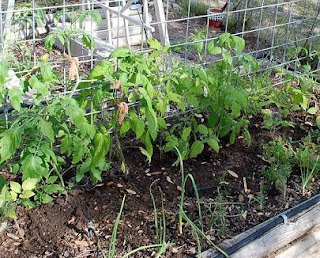 We pulled up the carrots that were in the way, dug a trench, and amended the soil with layers of shrimp shells, compost, pulverized egg shells, and a liberal sprinkling of epsom salts. We removed the bottom leaves of the plants (two Roma, four Oaxaca Pink heirlooms, four Sweetie, and four Brandywine heirlooms--I saved San Marzanos and persimmon tomato seedlings for our second crop) and burried the bottom two-thirds of the plants in the soil. We used old pantyhose to gently tie the plants to the fence. Pantyhose are stretchy and they don't "bite" into the stalks of the plants--and they're free!
We pulled up the carrots that were in the way, dug a trench, and amended the soil with layers of shrimp shells, compost, pulverized egg shells, and a liberal sprinkling of epsom salts. We removed the bottom leaves of the plants (two Roma, four Oaxaca Pink heirlooms, four Sweetie, and four Brandywine heirlooms--I saved San Marzanos and persimmon tomato seedlings for our second crop) and burried the bottom two-thirds of the plants in the soil. We used old pantyhose to gently tie the plants to the fence. Pantyhose are stretchy and they don't "bite" into the stalks of the plants--and they're free! Our tomato plants certainly seemed to be very happy--that is until Sunday night when we were surprised by a forecast for a light freeze. We gently covered our tomato fence with sheets covering the plants and felt pretty confident that they could easily withstand the sudden, cold temperatures. But the weather man was wrong! I woke up at three o'clock that morning and checked the temperature--twenty-seven degrees.
Our tomato plants certainly seemed to be very happy--that is until Sunday night when we were surprised by a forecast for a light freeze. We gently covered our tomato fence with sheets covering the plants and felt pretty confident that they could easily withstand the sudden, cold temperatures. But the weather man was wrong! I woke up at three o'clock that morning and checked the temperature--twenty-seven degrees. I panicked, of course and was delighted to find that other than a little frostbite,our tomato plants looked alive and well. Tuesday night (also a freeze warning) we added a blanket over the sheets. The tomato plants survived, thank goodness. Serious gardeners here in the Texas hill country plant their tomatoes in the ground as early as possible because we all know that by the first of July, temperatures will likely register at the one hundred mark and the tomatoes will collapse from the unrelenting heat.
The Texas hill country has been likened to Tuscany and the south of France. It's virtues are so extolled that city and county governments cannot possibly keep up with the rapid growth by city-dwellers seeking a peaceful, country life. This is a beautiful place to live with its quaint, picturesque German villages, numerous wineries that dot the countryside, and breathtaking views of rolling hills with wide expanses of lavender and bluebonnet fields. There is a culinary aesthetic here that satisfies the pickiest foodie and the music that swings through these hills rivals Nashville. But, as newcomers soon find out after they settle here, the Texas hill country is a lure and a trap--as Robert Caro wrote in his first award-winning biography of President Lyndon Johnson, The Path to Power. Only a thin layer of heavy, caliche clay soil covers an almost-solid limestone foundation, thwarting efforts to successfully raise all but native vegetation. But new arrivals to the hill country are shocked when they discover that THERE IS NO WATER.


No comments:
Post a Comment
We appreciate your comments.